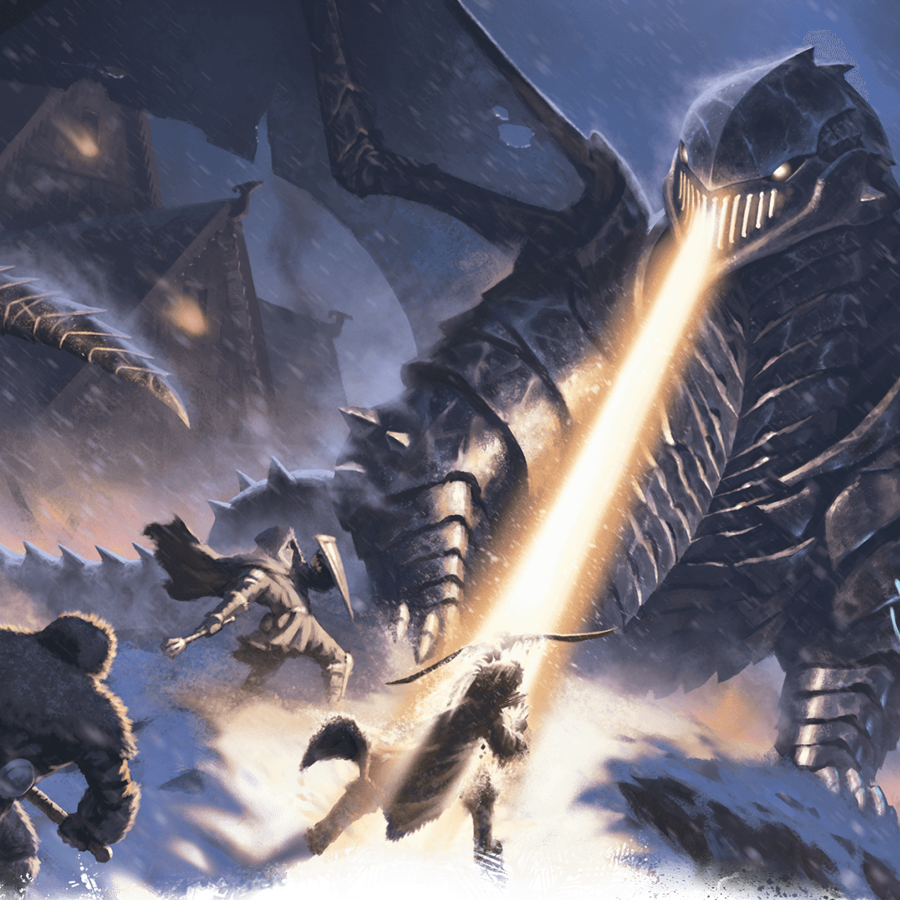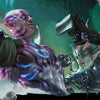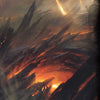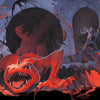How to Create a D&D Campaign Arc

Written by Luke Hart
Campaign drifting is a plague upon humanity. It is something that game masters should vigilantly guard against because once your campaign begins to drift, few things in the known universe can save it from a dire fate.
I exaggerate, of course, and we should probably define what “campaign drifting” even is. If you’ve ever been in an ADD game that suffered from campaign drifting, you’ll know exactly what I’m talking about. Campaign drifting is when a game seems to “drift” from one adventure to the next without any overarching theme, story, or goal to tie them together. Campaign drifting often happens when players randomly wander around the world doing random stuff. Other times, campaign drifting happens because the game master does nothing to provide an overarching campaign throughline.
The issue with campaign drifting is that most players enjoy the story that unfolds during gameplay just as much as they enjoy the combat, social interactions, or other elements. When you have campaign drifting, it’s not so much that you don’t have a story but that the story tends to be far inferior to what it could have been. So, you end up running a game that isn’t as fun as it might be. When it comes down to it, solving for campaign drifting isn’t that hard.
Today, we’re going over how to avoid campaign drifting by creating a core conflict in your campaign. This might also be referred to as a campaign throughline, the central theme or conflict that pervades most, if not the entire, campaign.
Watch or listen to this article by clicking the video below.
Now, the core conflict of the campaign is the central conceit, the inspiration for the entire story that the game master and players will tell as the campaign unfolds. The core conflict of a D&D campaign can be defined with a simple statement using one or more of the 5 W’s and an H: who, what, why, when, where, and how.
The simple statement you create will serve as the central principle around which you construct your entire campaign. So, let’s break down how to create this core conflict statement.
#1 Ask “Who?”
First, ask yourself who is inciting the conflict. I answer this question by thinking about which villain or monster I want to base the campaign around. Of course, this will be a high-level creature. For instance, if my campaign will go to level 20, I might want this to be a level 25 creature. However, if my campaign will only go to level 10, I might want the creature to be level 12 or so.
For instance, you may want to use an ancient red dragon as the main antagonist, and you plan to build your entire campaign around that creature.
Another way you can do this is by beginning with an idea that deals with a less distinct “who,” such as an evil king against whom the characters will need to lead a rebellion. This gives you the freedom to decide what kind of creature the villain is as you further develop your campaign concept or the story unfolds. This also allows you to adjust the creature type based on the characters and their backstories.
In my Sword Coast Guard campaign, the main villain, Lord Paxton, was completely undefined for much of the campaign. It was only when the characters reached level 12 or so that I narrowed it down to Lord Paxton being an ascended storm giant, and even then, I didn’t know what stat block I would use. I didn’t actually choose Lord Paxton’s specific stat block or details until I was prepping the final adventure, where the characters would confront Lord Paxton in a final showdown.
#2 Ask “What?”
Next, ask yourself what the main villain is trying to accomplish. This question is often framed as “Now that you know who the villain is, what do they want?” But you don’t actually need to know who the villain is to answer this question. As mentioned, you might have left the main villain a little nebulous.
The “what” that we are answering with this question is simply the goal, and the main antagonist can be defined by the goal just as easily as the goal can be defined by the antagonist.
For example, you may want to run your campaign around the threat of the great old ones returning to the world to devour all life. In our ancient red dragon example, you may decide its goal is to ascend beyond mortality to become an avatar of its dark goddess. Or, based on the idea of an evil king that the characters will rebel against, the goal may be as simple as squashing the rebellion and remaining in power.
#3 Ask “Why?”
The third question you need to ask of your villain is why they are doing it. This “why” defines the villain’s motivations, the reasons they’re trying to achieve their goal. Now, here’s the thing, the why often appears obvious at first, but a good why has more to it; it goes deeper.
In our red dragon example, it might be easy to say that the dragon wants to become an avatar of its goddess because it craves power. However, it’s far more interesting to say that the dragon wants to transcend mortality because it has learned of a prophecy that foretells its death. This prophecy speaks of a gold dragon who currently slumbers but will awaken on the first day of winter. Thus, the ancient red dragon is seeking power not for power’s sake but to protect its own existence.
In our example with the rebellion, the motivation for the king wanting to retain his power may seem obvious. He doesn’t want to lose his power! However, what if there is a deeper, secret motivation? What if the king originally came to power through a pact he made with an archdevil? And the terms of that pact state that when the king loses control of his city, the archdevil will come to claim the city for itself. So, the king is protecting his own power, but he is also trying to protect everyone in the city from this archdevil.
#4 Ask “When?”
The next question you want to ask yourself is, “When does the goal need to be achieved?” This could mean a few different things. The “when” could be a deadline for the villain to achieve their goal. However, I believe a better way to implement this would be to have the “when” represent a deadline for the characters. What if there is a certain date by which the characters must stop the villain? Or what if they need to stop the villain before a specific event occurs?
Now, while a villain doesn’t always have to have a deadline, a good “when” creates a clock for the characters because having a deadline increases drama and tension. Ultimately, those lead to more enjoyable games and fulfilling stories.
For example, our red dragon may only be able to complete its ascension ritual on the winter solstice. Or, the longer the rebellion continues, the more likely it will be that the archdevil will return and wrest the city from the king’s hands.
#5 Ask “Where?”
The game master’s first spark of an idea might actually begin here. It’s just as easy to be inspired to run a campaign based upon a game setting as it is a villain or monster.
For instance, while preparing for my Pathfinder 2 campaign, Thieves Abound, I planned to run the campaign in the Eberron campaign setting. As I read through the different geographical locations in that setting, Mror Holds stuck out to me. For whatever reason, I just liked that location, so I decided to run my campaign there. At that point, I had to ask myself who would be the main villain.
The “where” should inspire ideas, such as the environment, creatures living there, and so on. However, it should not limit the game master’s or players’ freedom to explore parts of the locale that interest them.
For example, a campaign set in the River Kingdoms of Golarion may include adventures wherein the characters travel to the strange lands of Numeria within the twisted theocracy of Razmiran.
Likewise, a campaign set in “The Frozen North” could include an adventure that requires the characters to travel to a mysterious jungle in a magical “tropical bubble” that exists around an ancient volcano in the otherwise arctic environs.
For my Thieves Abound campaign, I fully intend to present opportunities for the characters to travel to other parts of Eberron. I mean, there is so much cool stuff out there to explore and learn about that it would almost seem to be shortchanging my players if they were not allowed to experience more of what the Eberron campaign setting has to offer.
#6 Ask “How?”
Next, you need to ask yourself how the villain intends to achieve their goal. In many cases, the “how” will be the source of the campaign’s main conflict.
You see, a dragon who wants to become an avatar of their goddess before the winter solstice isn’t necessarily a problem. If that dragon doesn’t have a method for achieving its goal, it is not a threat to the world, and there’s no game to play, really.
However, when that same dragon starts sending hordes of kobolds to steal an arcane tomb from the city’s library or an army of lizardfolk to raise a town and draw out the young silver dragon hiding there, well, that creates conflict. A D&D or Pathfinder 2 game without conflict is not a game at all.
This “how” should start with the overarching “how” of the entire campaign, but it should also provide a framework for all the little hows that will inspire the smaller adventures that make up the campaign.
For instance, the red dragon may need to sacrifice one of every kind of metallic dragon over the course of the campaign to ascend to avatar status. To accomplish that “how,” the red dragon will need to gather minions to acquire an ancient tomb that contains the rituals required for the ascension: find metallic dragons to sacrifice, capture them, and transport them to locations for sacrifice. All of these items can be sources of specific adventures throughout the campaign.
Bring It All Together
Now that you have at least a few of the five whys and an H identified, you can produce the core conflict statement. For example, an ancient red dragon wants to ascend to become an avatar of its dark goddess by sacrificing five metallic dragons when the stars align on the winter solstice.
This core conflict statement will serve as the central principle around which you will construct the entire campaign. There may be some unrelated side quests or character backstory side quests; however, how that central principle creates conflict in the world and what can be done to prevent it are the motivations behind all the central campaign adventures.
Using that central principle, you can flesh out the campaign’s major milestones, minor villains, and the creatures and adventures that get the characters from their first adventure at level one to the campaign’s climax at level 10, 15, or 20.
Your next step is to begin fleshing out some of the details of your campaign, so we’ll go over some of the questions you can ask yourself and the steps to do this.
However, let me insert a warning right here. It will be very easy for you to get lost in the weeds and over plan at this point. This can either lead to you doing a lot of work you’ll never use or, worse yet, cause railroading to get the characters to do what is needed to “tell the story.” So, my suggestion is to not overdo it. Focus your planning on the 1st adventure, though you may want to look ahead for the types of creatures you want to use in the future and so forth. Just don’t go crazy.
How Is Conflict Created?
We touched on this briefly, but it’s very important to ask yourself, “How do the villain’s methods and goals create conflict in the world?” Remember, if your villain doesn’t create conflict, there’s no reason for the characters to get involved, and you have neither a game nor a campaign.
As the game master, you will have a high-level picture of how the villain and all his minions are causing problems in the world; however, your players don’t need to know everything. Instead, reveal only a little to them. They really only need to know the problem your villain is causing for their first adventure. You don’t want to reveal too much of the villain’s plans too early on. Not only does this ruin mystery and suspense, but it could also paint you into a corner. The moment you reveal information, you really can’t change it. There are advantages to leaving things undefined so that you can change them in the future as needed.
Furthermore, if you take the focus off the current adventure, the players might get sidetracked or try to solve the entire campaign before taking their first steps. Imagine if, at level one, your characters march off to the ancient red dragon’s lair to take care of business. That would probably be a short campaign, wouldn’t it? Instead, at level one, all the characters need to know is that the kobolds broke into the library and stole an ancient tomb that must be recovered.
The very first adventure of your campaign may or may not be part of this central campaign arc. I personally prefer to get right at it, but other game masters like to start with something unrelated and then reveal the central campaign conflict a little later.
If you’re running a shorter campaign, I suggest jumping right into the core conflict. However, if your campaign is longer, you have more flexibility.
Now, if you’re wondering what adventures should make up your campaign, there is a fairly easy way to determine this. Basically, you want to take your core conflict statement and figure out the steps the villain needs to take to succeed. Each of these steps can be an adventure that the characters go on to thwart the villain.
In the example of our ancient right dragon, it must acquire an ancient tomb and abduct one of each type of metallic dragon. Those are all things that you can create adventures around.
What Are the Minions Doing?
The next thing I like to ask myself is who the villain’s minions are and how they will use them to achieve their goals.
Some game masters will tell you to pick minions that make sense for the villain. This is good advice because it will help your adventures and campaign seem thematically related. However, don’t limit yourself by that advice. You can easily think of why devils would work with the red dragon, even if it doesn’t seem like the most obvious choice at first.
In fact, sometimes turning expectations on their head is more interesting. An archdevil has access to devils of all challenge levels. However, an adventure where the main enemies are angels that the devil has tricked into serving its purpose makes for an unexpected twist with interesting options for approaching the challenge. Will the characters just slaughter the angels? Or will they try to figure out a way to show the angels what’s really going on?
At the same time, there are plenty of reasons to use creatures that are thematically related to the main antagonist. If you have kobolds and lizardfolk in the early adventures, that can foreshadow the possibility of a dragon. Scum and faceless stalkers might make players start to worry about the imminent arrival of an aboleth. You see, foreshadowing is a powerful tool.
However, I think the most important consideration is choosing minions and monsters you want to use—creatures that will be fun for you. Remember, as the game master, you are allowed to have fun. In fact, if you ever get bored and stop having fun, chances are your campaign will die soon after.
Now that you have your minions figured out, all that remains is to determine what the minions are doing to help the main antagonist achieve their goals. Their actions will form the backbone of your group’s early adventures.
How Are the Characters Involved?
All of your campaign planning is for nothing if the characters never get involved with the central conflict. So, you need to ask yourself, “What motivates the characters to get involved?” Is one of the characters a mercenary who’s only interested in money? Is one of the characters a farm boy, inspired by stories of his heroic father, who wants to do good in the world? Is one of the characters a princess who wants to regain her family’s respect after falling from grace? Using these motivations to hook the characters will show your players that you’re paying attention to their characters, which will help hook them, too.
Now, there is nothing wrong with simply creating adventures and a campaign conflict that relies on the social contract. That is, the characters are expected to solve the problem because the game master put the problem there. However, the less you can rely on that, and the more you can appeal to the characters’ or your players’ desires, the more compelling your game will be. One thing you can do is weave the characters’ backstories into the core conflict. If possible, tie the characters’ backstories directly into the core conflict.
For instance, a cloistered cleric who has spent much of their life in a monastery might seek to recover lost homes, and one of those lost homes is the one that the dragon needs to ascend to demi-godhood. Or a peasant hero may learn that their heroic deceased father is secretly the villain’s most powerful lieutenant.
My big warning here, though, is to be careful not to tie a character into the core conflict so completely that you need to keep that character alive. Avoid putting yourself in a situation where plot armor becomes a necessity.
Look for Examples!
Now, if you’re still a bit hazy about what a central conflict is or what your essential conflict might even look like in your game, I suggest looking for and studying examples.
The first place that you can find examples is published campaigns. For instance, you might pick up Into the Fey off the DM Lair store and see how I created the central conflict for that campaign. Or, if you play Pathfinder 2, grab an adventure path.
You can also look at inspirational media. Most RPGs draw inspiration from one or more novels, novel series, television series, films, or series of films—sometimes, all of the above. There are countless examples of great science fiction and fantasy series that have been inspirational for games, and many game systems are licensed from a specific source, such as the Star Wars and Star Trek RPGs.
Movies are also great examples of shorter campaigns, and some films are created in trilogies that demonstrate how a core thread can move through several adventures. Star Wars and Lord of the Rings are good examples of this. Stand-alone movies should generally be viewed as examples of how a single adventure or one-shot might function.
Literature is another excellent place to look for examples. In fact, novels tend to go into more detail than a film or series of films, and many stories, especially genre stories, are told across multiple novels. The Hobbit and The Lord of the Rings trilogy are a master class in using a core conflict across a long campaign. Right now, I’m reading Brandon Sanderson’s Mistborn series, which is fantastic. I also really enjoy the Wheel of Time series by Robert Jordan and Song of Ice and Fire by RR Martin.
The Ultimate 5e Anthology for DMs
Lairs & Legends 2 and Loot & Lore 2 are the ultimate game master resource! These two massive books put an anthology of everything you need to run amazing games for YEARS at your fingertips.
- Over 30 Adventures
- 30 Stand-Alone Encounters
- More than 100 Monsters
- Traps and Puzzles
- 6 New Rule Sets
- And much more!
These books are written to make running the game easy for new and veteran GMs. Each resource is built with intuitive formatting, clear wording, and evocative art. You’ll never again have to dig through dense paragraphs to find critical details you need during a live session.
These 5e resources are designed to scale to your needs, whether it’s a quick drag-and-drop trap to add some spice to your session or complete adventures that span levels 1 to 20. The sky’s the limit with what your games can become with Lairs & Legends 2 and Loot & Lore 2.
-
Posted in
Game Master How-To Articles






